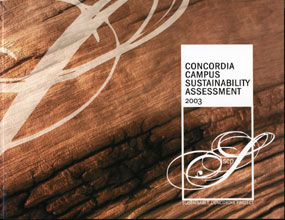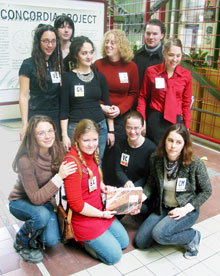Sustainability Assessment launched with real enthusiasm

Students in the Sustainable Concordia Project (SCP) were triumphant on Feb. 3 at lunchtime as they presented the results of the first phase of their work to a full house in the DeSève Cinema.
Outside, in the atrium of the McConnell Building, interested observers looked at big posters and displays of a waterless urinal, a worm composter, a tactile mapping project for visually impaired students and the Solar Decathalon, which is a competition among engineering students to design an environment-friendly house.
Melissa Garcia-Lamarca, who started the assessment with Geneva Guérin in 2002, and Jenn Davis described the project, which sets ambitious goals for recycling, energy efficiency, safety, and social equity.
Geography professor Catherine Moore spoke about the concept of sustainability. As defined in the groundbreaking Brundtland Report of 1987, it means development that meets the needs of the present without compromising the ability of future generations to meet their own needs.
“While initially nebulous, the concept has now crystallized around three integrated elements: economic prosperity, ecological integrity, and social equity,” she said.
“Campus sustainability projects have multiplied over the past decade, both in North America and elsewhere. Most universities conducting evaluations of their sustainability in the early 1990s did so from an exclusively ecological perspective.
“Concordia University’s first sustainability assessment is among the most comprehensive to date.”
The SCP employed the Campus Sustainability Assessment Framework developed by Lindsay Cole, a master’s student at the University of British Columbia, who attended the celebration.
Also on hand was Andrew Nixon, who ranked university sustainability assessments as part of his academic work at Western Michigan University. In fact, the Concordia Campus Sustainability Assess-ment (CCSA) ranked second (after Penn State) out of an astonishing 1,200 university sustainability assessments in Nixon’s survey.
Rector Frederick Lowy made a short congratulatory speech, and the students have been told that the CCSA will figure in Concordia’s 30th anniversary celebrations this year.
The centerpiece of the SCP’s achievement is a handsome book, produced entirely by the students. In the interests of conservation, only 100 copies have been printed, but the contents are already online, at www.concordia.ca/sustainability.
Melissa and Jenn paid tribute to all the Concordia employees who co-operated with the students as they conducted an exhaustive audit of the university’s physical, social and administrative activities.
The fundamental idea behind the project is for sustainability to become continuous and pervasive. The students and their supporters, including a number of faculty and staff members, want this ideal to drive the daily functioning of the institution.
They also encourage students in all disciplines to conceive and undertake sustainability projects of their own.
The project was well supported from the first by Vice-Rector Services Michael Di Grappa, largely through the efforts of Sue Magor, director of Environmental Health and Safety.
“I am tremendously impressed with the interest and support this project has generated from all levels and across all sectors of the university community,” Magor said. “Rarely have I seen students, staff and faculty collaborate so effectively on a student-initiated project.
About $45,000 has been given to the project. About $28,000 was start-up money that covered the salaries of two student auditors, Garcia-Lamarca and Guérin, and the printing of the 400-page assessment document.
While the Vice-Rector Services was the major source of funding, donations were also given by the Rector’s Cabinet, the five deans, the Concordia Council for Student Life, and Vice-Rector Institutional Relations and Secretary-General Marcel Danis.
If you have an idea for the Sustainable Concordia Project, contact sustainability@riseup.net, 2100 Mackay, Room 101, or 848-2424 ext. 5829.

Seen at the launch are some of the many students who worked on the Sustainable Concordia Project. Back row to front, left to right: Vera Zissis, Allysha Larson, Gida Hamam, Tanya Aberman, Mathieu Rioux, Chantal Beaudoin, Alicia Mace, Bronwen Agnew, Varina Cristfield and Caley Mulholland.
Photo by Greg Fretz
The breath that links us across the ages
Catherine Moore, a lecturer in the Department of Geography, Planning and the Environment, has been actively involved in the sustainability project and teaches a new course, University Sustainability. She spoke at the launch of the SCP assessment, using an image from David Suzuki’s Sacred Balance.
Take a breath.
With that single breath you have inhaled about 30 quintillion (3 x 1019) atoms of argon, an inert gas that resides for a time within an organism but is not assimilated.
With that single breath you have inhaled more than 400,000 of the argon atoms that Gandhi breathed in his long life. Argon atoms are here from the conversation at the Last Supper and the discourses of Socrates, from Neanderthals and Australopithecus, Tyrannosaurus rex and woolly mammoths.
Now, exhale.
Within a year, the argon from that single breath will have diffused around the planet. That single breath will become part of living beings of the present and those of the future.